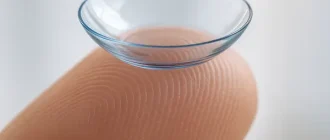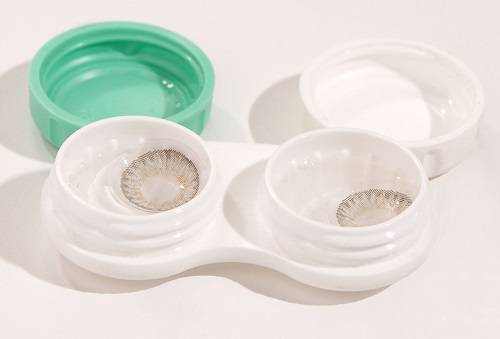Have you ever wondered why your eyes sometimes feel dry, itchy, or tired after wearing contact lenses all day? Perhaps you’ve heard about silicone hydrogel contact lenses and how they offer a more comfortable experience. But what exactly makes these lenses stand out from the rest?
Oxygen Permeability Comparison: Silicone Hydrogel vs. Conventional Hydrogel Contact Lenses
| Lens Type | Oxygen Permeability (Dk/t) |
|---|---|
| Silicone Hydrogel | 90 Dk/t |
| Conventional Hydrogel | 30 Dk/t |
This chart illustrates the difference in oxygen permeability between silicone hydrogel and conventional hydrogel contact lenses, highlighting the superior oxygen transmission of silicone hydrogel lenses for healthier corneal health.
What Are Silicone Hydrogel Contact Lenses?
Silicone hydrogel lenses represent the next level in contact lens technology, offering a unique combination of comfort and breathability. Unlike conventional hydrogel lenses, which rely solely on water content to keep your eyes moist, silicone hydrogel lenses are made with a material that permits higher oxygen permeability. This means that more oxygen reaches the cornea, reducing the risk of irritation and infections.
Did you know? According to a 2023 report by Contact Lens Spectrum, silicone hydrogel lenses account for over 75% of all soft lenses prescribed in the U.S. due to their superior oxygen transmission and comfort.
The Science of Comfort: Why Oxygen Matters
Imagine wrapping your skin in plastic for hours. Uncomfortable, right? Now imagine your eyes being deprived of oxygen for extended periods. Standard hydrogel lenses provide a limited flow of oxygen, which can lead to dryness, redness, and discomfort. Silicone hydrogel lenses are designed to mitigate these issues. The silicone component allows significantly more oxygen to pass through the lens to the cornea—up to five times more than traditional hydrogels.
Dryness Incidence Rate by Lens Type
| Lens Type | Dryness Incidence Rate (%) |
|---|---|
| Silicone Hydrogel | 30% |
| Conventional Hydrogel | 60% |
This chart compares the dryness incidence rate between silicone hydrogel and conventional hydrogel contact lenses, demonstrating that silicone hydrogel lenses have a significantly lower rate of dryness, promoting greater comfort for long-term wearers.
This is crucial for maintaining corneal health, especially for individuals who wear lenses for extended periods. In fact, a study by the American Academy of Ophthalmology found that users of silicone hydrogel lenses reported 45% fewer instances of dryness compared to those using regular hydrogel lenses.
Are Silicone Hydrogel Lenses Worth the Cost?
A common question people have is whether silicone hydrogel lenses are worth the extra cost. Prices can vary, but on average, these lenses cost around $25-$45 per box, which is slightly more than conventional hydrogel lenses. But what are you really paying for? Primarily, it’s about long-term eye health and comfort.
When you consider that higher oxygen permeability means reduced chances of developing conditions like corneal hypoxia (a lack of oxygen to the eye) and fewer discomfort issues, the additional investment seems more justifiable. After all, eye health isn’t something to skimp on, especially when discomfort might mean you’ll need to switch to glasses far earlier than planned.
Trends and Modern Innovations
Silicone hydrogel lenses are evolving rapidly. With modern advances, some lenses are now specifically designed for extended wear—meaning you can keep them in for up to 30 days without removing them. This isn’t recommended for everyone, of course, and always requires a doctor’s approval. However, for those who need a highly convenient solution, this trend toward “continuous wear” lenses is intriguing.
Another recent trend is the introduction of lenses incorporating UV blockers. Given the rising awareness about UV damage, manufacturers are increasingly adding UV protection to contact lenses to help reduce potential harm from sun exposure. Remember, however, that these lenses are not a substitute for sunglasses.
Common Myths and Misconceptions
- Myth: Silicone hydrogel lenses are only for people with special prescriptions. Not true! These lenses are available in a wide range of prescriptions, including for astigmatism and multifocal needs.
- Myth: All silicone hydrogel lenses are the same. They may share common material properties, but different brands can vary greatly in terms of fit, comfort, and other features. Always consult your eye doctor for the best fit for your eyes.
Practical Tips for Users
- Clean Properly: Always clean your lenses with a suitable solution to avoid infection.
- Replace as Recommended: Even if they feel fine, always replace your lenses according to the manufacturer’s schedule. Extended use beyond the recommended timeframe increases risks.
Did you know? A survey by the American Optometric Association in 2022 found that nearly 60% of contact lens users extend their lenses beyond their recommended wear period—a dangerous habit that can lead to complications like infections and corneal ulcers.
Our Editorial Advice
Silicone hydrogel lenses offer significant benefits for anyone looking for greater comfort and healthier eyes during contact lens wear. If you’ve been experiencing discomfort with traditional hydrogel lenses or want to ensure your eyes get the oxygen they need, it might be time to talk to your eye care professional about making the switch. Just remember—like all contact lenses, the key to maintaining eye health lies in consistent hygiene and following wear guidelines.
Duration of Safe Wear for Different Contact Lens Types
| Lens Type | Safe Wear Duration |
|---|---|
| Daily Disposable Lenses | 1 Day |
| Two-Week Lenses | 14 Days |
| Monthly Lenses | 30 Days |
| Extended Wear Lenses | 30 Days (Continuous) |
This chart shows the recommended safe wear duration for different types of contact lenses, emphasizing how long each type can be safely worn before replacement is necessary to maintain optimal eye health.





